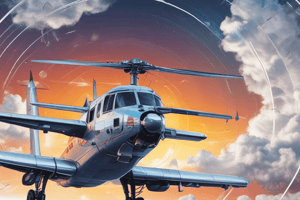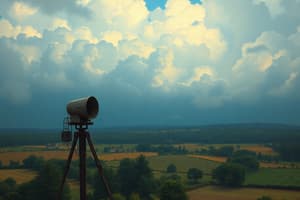Podcast
Questions and Answers
What type of radar is used for precipitation detection?
What type of radar is used for precipitation detection?
- Phased array radar
- Doppler radar
- S-band radar (correct)
- X-band radar
What is the primary function of an anemometer?
What is the primary function of an anemometer?
- To measure wind speed and direction (correct)
- To measure atmospheric pressure
- To measure humidity
- To measure temperature
What is the main focus of marine weather forecasting?
What is the main focus of marine weather forecasting?
- Predicting temperature and humidity
- Predicting atmospheric pressure and humidity
- Predicting wind, waves, and sea state (correct)
- Predicting ocean currents and temperature
What type of radar measures velocity of particles in the atmosphere?
What type of radar measures velocity of particles in the atmosphere?
What is the purpose of upper air observation stations?
What is the purpose of upper air observation stations?
What is a storm surge?
What is a storm surge?
What is the primary application of phased array radar?
What is the primary application of phased array radar?
What is the primary function of a hygrometer?
What is the primary function of a hygrometer?
What is the primary application of X-band radar?
What is the primary application of X-band radar?
What is the primary application of radiosondes?
What is the primary application of radiosondes?
Study Notes
Weather Radar
- Uses radio waves to detect precipitation and other weather phenomena
- Types of weather radar:
- Pulse radar: emits high-powered pulses of radio energy
- Doppler radar: measures velocity of particles in the atmosphere
- Phased array radar: uses electronic scanning to steer the beam
- Radar frequencies:
- S-band (2-4 GHz): used for precipitation detection
- C-band (5-7 GHz): used for wind profiling and tornado detection
- X-band (8-12 GHz): used for high-resolution precipitation detection
- Radar applications:
- Precipitation forecasting
- Severe weather warning
- Aviation weather forecasting
- Hydrological forecasting
Meteorological Instrumentation
- Surface weather observation stations:
- Measure temperature, humidity, wind direction, wind speed, and atmospheric pressure
- Can be automated or manual
- Upper air observation stations:
- Use radiosondes to measure temperature, humidity, and wind speed aloft
- Launched using balloons or aircraft
- Remote sensing instruments:
- Satellites: measure cloud top temperature, humidity, and wind speed
- Radiosondes: measure atmospheric conditions aloft
- Radar: measures precipitation and wind velocity
- Specialized instruments:
- Anemometers: measure wind speed and direction
- Barometers: measure atmospheric pressure
- Hygrometers: measure humidity
Maritime Related
- Marine weather forecasting:
- Focuses on predicting wind, waves, and sea state
- Essential for safe navigation and offshore operations
- Oceanic and atmospheric interactions:
- Ocean currents and temperature affect atmospheric circulation
- Atmospheric conditions affect ocean waves and sea level
- Maritime weather phenomena:
- Storm surges: abnormal rise in sea level due to storms
- Rogue waves: unusually high and dangerous waves
- Sea fog: fog that forms over the ocean
- Applications of maritime meteorology:
- Offshore wind farms
- Ship routing and navigation
- Coastal erosion and flood protection
Studying That Suits You
Use AI to generate personalized quizzes and flashcards to suit your learning preferences.
Description
This quiz covers the principles and applications of weather radar, including types of radar and their frequencies. It also explores meteorological instrumentation, including surface and upper air observation stations, remote sensing instruments, and specialized instruments. Additionally, it delves into maritime-related topics, such as marine weather forecasting, oceanic and atmospheric interactions, and maritime weather phenomena.




